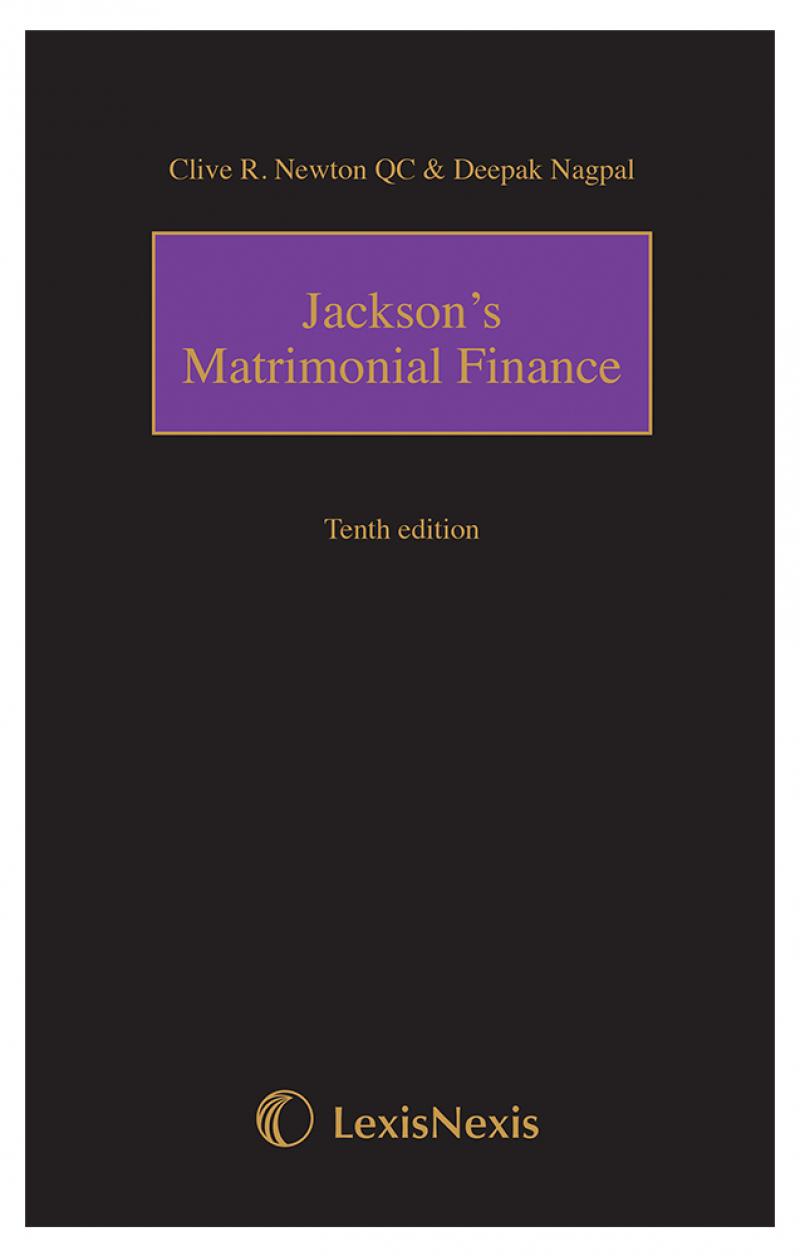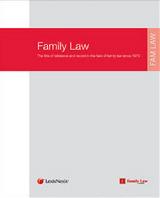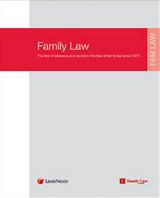- News & Comment
-
Online Shop
Online Services
Looseleafs
Law Reports
Books and eBooks
-
CPD & Events
Webinars
Events
- Authors
- About Family Law
- Contact












 4 FEB 2025
4 FEB 2025

 3 FEB 2025
3 FEB 2025

 3 FEB 2025
3 FEB 2025

 3 FEB 2025
3 FEB 2025

 3 FEB 2025
3 FEB 2025






Tax can often be quite low down the list of priorities as something to think about during a relationship breakdown. However, in all but the most straightforward of cases, taking tax advice at an early stage is highly recommended. Unless the parties are properly advised unexpected tax bills can arise. Due to the time lag with self-assessment, realising there might be a tax liability can often be some time after the parties think that everything has been finalised and they can move on with their lives (for example a Capital Gains Tax (CGT) liability realised in September 2019 will not be payable until 31 January 2021).
Inevitably assets will be transferred between the parties as part of the dissolution of the marriage or civil partnership. Many individuals labour to a compromised position under the impression that they can give assets to each other with no CGT cost. This is indeed the case for spouses and civil partners who are living together as the “no gain/no loss” principle applies up to the end of the tax year of separation (see below).
Thereafter, the couple are in the worst of both worlds in so far as they are separated but are treated as “connected” for CGT purposes meaning that assets passing from one to the other are deemed to be disposed of at their market value.
A basic planning point is therefore not to separate on say 31 March, as this gives a mere 5 days to utilise the “no gain/no loss” principle, whereas a couple separating on the 6 April have a full tax year to transfer assets between them with no CGT implications. This could be helpful for illiquid or admin-heavy chargeable assets such as unlisted shares, property etc.
A couple will be treated as living together unless they are separated under a Court Order, a formal deed of separation or if they are separated “in such circumstances that the separation is likely to be permanent”. It is entirely possible for a couple to live in separate houses or indeed countries and still be treated as “living together” for CGT purposes. It will be a question of fact for each case.
Usually the most significant/valuable asset held is the former matrimonial home (FMH). A married couple or civil partnership can only have one main residence between them for CGT purposes. Once separated, they will revert to being assessed individually, i.e. they are then capable of having separate main residences/each claiming main residence relief.
There are a number of options for dealing with the FMH as a result of the divorce process, although this is becoming more difficult due to forthcoming changes to the CGT legislation which will invariably impact separating couples.
In very simple terms, where a property has qualified as the only or main residence (OMR) throughout the period of ownership, the capital gain on sale is exempt from CGT. Where the property does not qualify as the OMR throughout, the capital gain is time apportioned for the duration it has not been the OMR when working out the gain subject to CGT.
In circumstances where the property has qualified as the OMR at any point, currently the final 18 months of ownership is a deemed period of ownership for OMR purposes regardless of the property’s actual use in that time. This gives a certain amount of flexibility, for example if one individual has moved out of the FMH with the property sold subsequently, the entire capital gain can be tax free if the sale occurs within 18 months of separation. However, with effect from 6 April 2020, the final period exemption will be reduced to just 9 months, which will add much greater urgency/time pressure on sales.
The potential tax costs of this are best illustrated by an example:
John and Julie bought their home jointly in August 2009 for £500,000 where they lived until they separated in September 2018 whereupon John moved out. Julie continued to live in the house. They decided to sell and split the sale proceeds equally between them.
Sale in March 2020 for £850,000
| John’s share (£) | Julie’s share (£) | |
| Proceeds | 425,000 | 425,000 |
| Cost | (250,000) | (250,000) |
| Capital gain | 175,000 | 175,000 |
| CGT relief | (175,000)* | (175,000) |
| Taxable | Nil | Nil |
*Main residence relief available to John in full as his absence is covered by the final period of deemed occupation of 18 months (September 2018 – March 2020).
Sale in August 2020 for £850,000
| John’s share (£) | Julie’s share (£) | |
| Proceeds | 425,000 | 425,000 |
| Cost | (250,000) | (250,000) |
| Capital gain | 175,000 | 175,000 |
| CGT relief | (156,439)* | (175,000) |
| Taxable | 18,561 | Nil |
| CGT at 28% | 5,197 | Nil |
Main residence relief for John:
Total period of ownership = 132 months
OMR = August 2009 – September 2018 = 109 plus final 9 months = 118
OMR relief = 118/132 x £175,000 = £156,439
It is worth noting that the loss of main residence relief can potentially be mitigated by an election under section 225B TCGA 1992.
The following conditions must be met:
- Before separating John and Julie lived in the property as their main home
- Having ceased living in the property, John retained an interest in it
- Julie continued to live in the property
- John elected for no other property to be treated as his OMR during the period
Where the property is then transferred by John to Julie under a court order or another agreement, main residence relief is applied in full on the transfer by John. The election would not be available for a sale of the property to a third party with the proceeds split between them. As a result this election would not assist in the example above but could be valuable in other cases where one party will continue to live in the FMR.
It should also be noted that claiming main residence relief on the FMR under this section would prevent main residence relief from accruing on another property that John may have bought to live in and so may not be attractive in all cases. Clearly this depends on the numbers involved/which property is increasing in value the quickest.
It should be noted as well that from 6 April 2020 lettings relief will no longer be available unless the home is occupied by the owner at the same time as the tenant.
Currently, lettings relief is highly valuable as it allows a further exemption of up to £40,000 of gain (£80,000 for a jointly owned property) where a main residence has been let out at some point during the period of ownership. The potential tax costs of the reform of this relief could be as much has £22,400 (£80,000 at 28%).
Thus in circumstances where for example, a couple have separated and decided to retain the property and rent it out rather than sell it, they may wish to re-consider or sell before 6 April 2020 to obtain the full lettings relief whilst they can.
Using the above example:
John and Julie bought their home jointly in August 2009 for £500,000 where they lived until they separated in September 2015. Under a court order, the property was transferred to Julie in March 2016 with a deferred charge entitling John to 50% of the sale proceeds when the property was sold.
Julie did not want to live in the property so she moved out in March 2016 and decided to rent it out until the property was sold.
Julie’s position is:
| Sale in March 2020 (£) | Sale in August 2020 (£) | |
| Proceeds | 850,000 | 850,000 |
| Cost | 500,000 | 500,000 |
| Capital Gain | 350,000 | 350,000 |
| CGT Relief | (267,322)* | (233,333)* |
| Net Gain | 82,678 | 116,667 |
| Lettings relief | (40,000) | Nil |
| Taxable gain | 42,678 | 116,667 |
| CGT at 28% | 11,950 | 32,667 |
Sale pre-6 April 2020
Total period of ownership = August 2009 – March 2020 = 127 months
Main residence relief = August 2009 – March 2016 = 79 months plus final 18 months deemed occupation = 97 months = 97/127x£350,000 = £267,322
Sale post 6 April 2020
Total period of ownership = August 2009 – August 2020 = 132 months
Main residence relief = August 2009 – March 2016 = 79 months plus final 9 months deemed occupation = 88 months = 88/132 x £350,000 = £233,333
Pre 6 April 2020 - Maximum of £40,000, gain in let period or main residence relief. The maximum in this case is £40,000.
Post 6 April 2020 – Nil unless owner occupied rental
The higher tax cost for Julie means she is left out of pocket by £20,717 bearing in mind the change in legislation (unless the order reflects the tax costs).
As a final point to note, a further change from 6 April 2020 requires any individual realising a chargeable gain on the sale of UK residential property to file a tax return and pay the CGT within 30 days of the sale. If this deadline is missed late filing penalties will become due.
The above is just a broad outline of the basic principles and much more complex situations can arise when it comes to transferring chargeable assets between the parties to a marriage or civil partnership post tax year of separation.
It is worth bearing in mind the potential tax cost of the loss of main residence and lettings relief particularly if the sale of the property is to be postponed. The tax cost to one or both of the parties could be significant.





Leave a commentOrder by
Newest on top Oldest on top